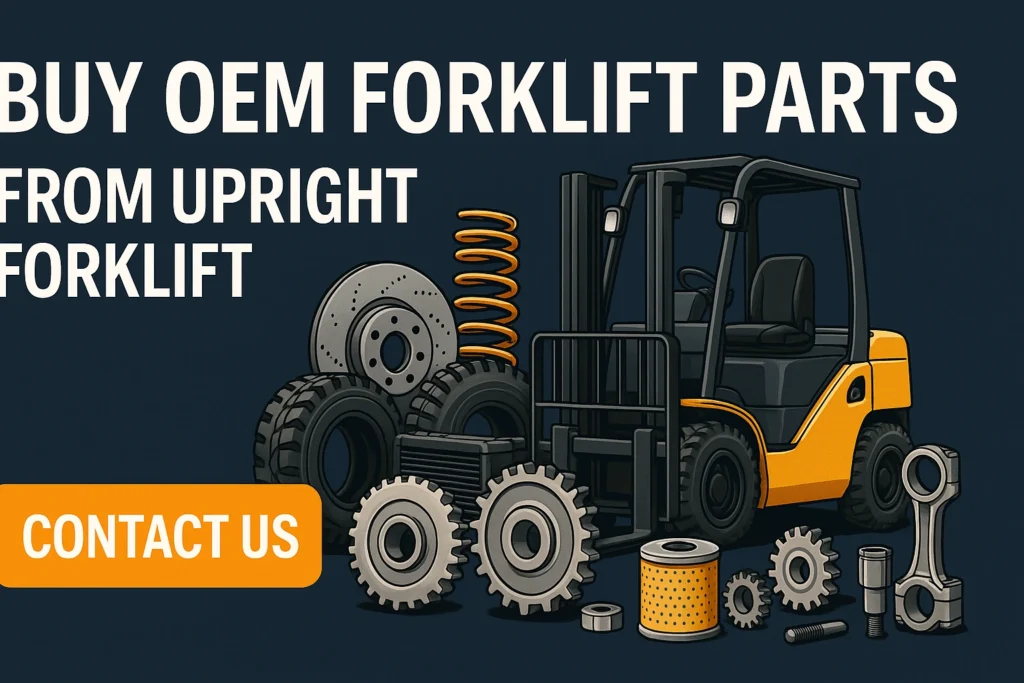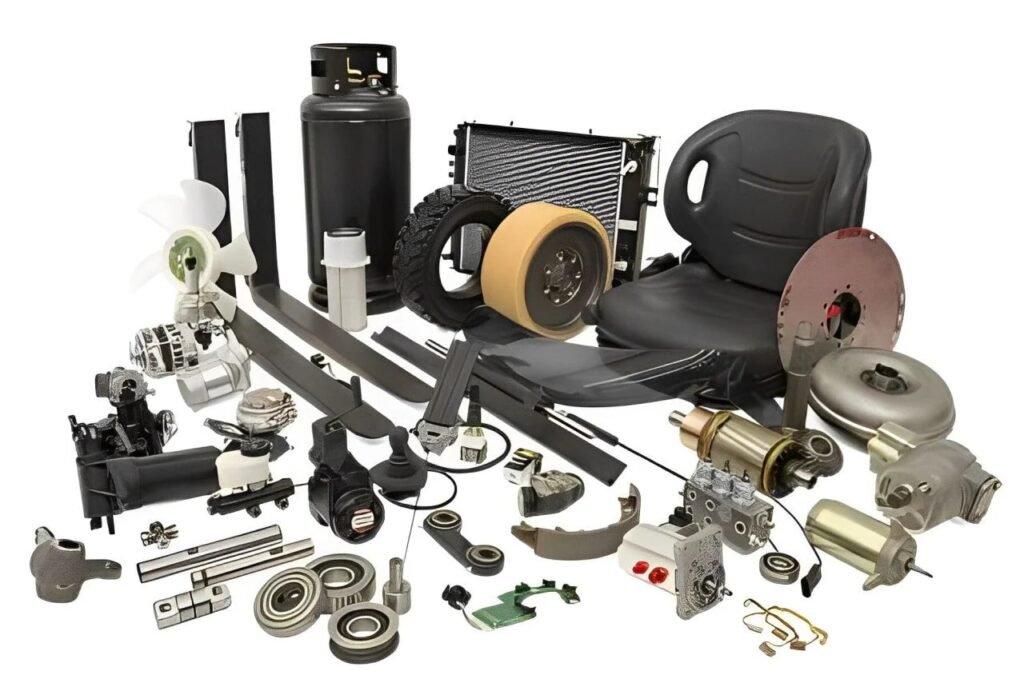When it comes to keeping your equipment running smoothly in Pearland, Houston, or Humble, choosing the right forklift parts can make all the difference. At Upright Forklift Repair, we specialize in expert forklift repair, maintenance, and supplying high-quality parts tailored for every job—whether it’s in warehousing, construction, or any kind of material handling environment.
One of the most common questions we hear is whether to go with OEM (Original Equipment Manufacturer) parts or aftermarket parts. Each option has its pros and cons depending on the type of forklift you operate—be it a compact electric forklift or one built for heavy materials and daily tasks in more rugged environments.
In this guide, we’ll break down the key differences, helping you choose the best fit for your electric models, lift trucks, and operational needs throughout Texas.
Understanding Forklift Parts: OEM vs. Aftermarket
What Are OEM Forklift Parts?

OEM, or Original Equipment Manufacturer parts, are components made by the same company that built your forklift. These quality parts are designed specifically for the make and model of your lift truck, ensuring seamless performance and maximum reliability. Whether you’re working with brands like Komatsu, Toyota, Clark, or Hyster, OEM parts provide an exact fit right down to the mast, axle, and overhead guards.
Using OEM parts means you’re replacing worn components with ones that match the original machinery specifications. This is especially important for newer or compact electric forklift models where precision matters most.
Benefits of Choosing OEM Parts for Your Forklift
One of the biggest advantages of using OEM parts is the peace of mind they offer. These parts come with a factory warranty, reducing the risk of premature failures and ensuring you’re backed by manufacturer support.
OEM parts are ideal for reducing downtime in operations that involve rough terrain, multi-shift usage, or electric models that require accurate integration with advanced safety features and electronics. For businesses in Houston, where fast-paced material handling is common, relying on OEM parts helps extend the lifespan of new models and maintain optimal performance.
What Are Aftermarket Forklift Parts?
Aftermarket parts are made by third-party manufacturers and are designed to fit and function similarly to OEM components. These parts are readily available for most major forklift brands, including Toyota, Komatsu, and others commonly used in houston industries.
They’re often used to replace worn forklift components like attachments, seats, or tires, especially when operators need quick solutions that don’t compromise productivity. You’ll find a wide selection, from standard replacements to high-performance upgrades, available for fast shipping and compatible with different lbs capacity requirements.
Advantages of Opting for Aftermarket Solutions
Aftermarket parts are often more cost-effective, making them ideal for companies trying to manage maintenance budgets without sacrificing quality. These parts are especially practical for older forklifts or lift trucks that may no longer be supported by OEM production lines.
With support from a team of experts like ours at Upright Forklift Repair, you can find reliable quality parts that suit your environment—whether you’re moving pallets in a climate-controlled warehouse or lifting heavy materials outdoors.
If your operation involves custom material handling needs, aftermarket parts also offer greater flexibility in design, allowing you to optimize your equipment for performance and efficiency.
Key Factors to Consider When Buying Forklift Parts?
Compatibility and Fitting Issues

One of the most important considerations when choosing between OEM and aftermarket forklift parts is compatibility. While OEM parts are built to precisely fit your forklift model—down to the mast, axle, and hydraulic connections—aftermarket parts may vary in design, which can lead to fitting issues if not sourced properly.
This is especially true for modern electric models and compact electric forklifts, where even a small variation can affect performance or safety. The type of environment you operate in also plays a role. In heavy-use conditions—such as warehousing, rough terrain, or outdoor work with LPG-powered forklifts—accurate fitting is essential to avoid breakdowns and maintain operational safety.
Choosing the wrong part could lead to extra labour costs, more frequent replacements, or even damage to other components, so compatibility should never be overlooked.
Warranty and Support Differences
Another major factor is the level of warranty and support you’ll receive. OEM parts usually come with a manufacturer-backed warranty, offering solid protection and long-term peace of mind, especially for businesses using newer machinery in mission-critical tasks.
On the other hand, aftermarket parts may come with limited or third-party warranties. While some aftermarket brands are reputable, others may lack support if something goes wrong.
This is where working with a local provider like Upright Forklift Repair in Houston and Humble makes a big difference. Our team of experts helps you navigate the pros and cons of each option, ensuring you get the right part with trusted support and professional forklift repair services that keep your operations running smoothly.
Cost Comparison: OEM vs. Aftermarket
When it comes to pricing, aftermarket parts are typically more cost-effective, often priced 20–40% lower than OEM alternatives. This can be a smart solution for businesses focused on routine maintenance, managing large fleets, or working with older forklift models.
However, for new forklifts or advanced equipment used in high-demand environments, investing in OEM parts may save you money over time by reducing downtime, improving efficiency, and protecting your best equipment.
Upright Forklift Repair works with you to determine the most economical choice, factoring in shipping times, part lifespan, and the overall impact on your workflow—whether you’re moving heavy materials in a large warehousing facility or running daily lifts in compact workspaces.
Conclusion
Choosing between OEM and aftermarket forklift parts comes down to your specific needs, budget, and the type of forklift you operate. OEM parts offer a perfect fit, factory support, and long-term peace of mind, making them ideal for newer models and high-demand applications. On the other hand, aftermarket parts are often more affordable and flexible, especially for older machines or less intensive use.
At Upright Forklift Repair, we provide expert advice and access to a wide range of quality parts—helping you minimize downtime and maximize performance. Whether you’re working in Dallas, Humble, or Pearland, our team is ready to support your forklift repair and maintenance needs with reliable, efficient service and trusted local support.
Final Verdict: OEM vs Aftermarket Forklift Parts in PearlandQuestions
What is the most cost-effective option for forklift parts in Pearland?
The most cost-effective solution depends on your forklift’s age, usage level, and work environment. For operations handling daily tasks, warehousing, or working with older models—aftermarket parts often offer the best value. They’re widely available and offer flexible options for various electric models, rough terrain, or compact electric forklift types.
However, for high-performance or newer machines, OEM parts may help avoid long-term issues. At Upright Forklift Repair in Houston, we help you balance cost, performance, and material handling demands to find the right quality parts for your needs.
